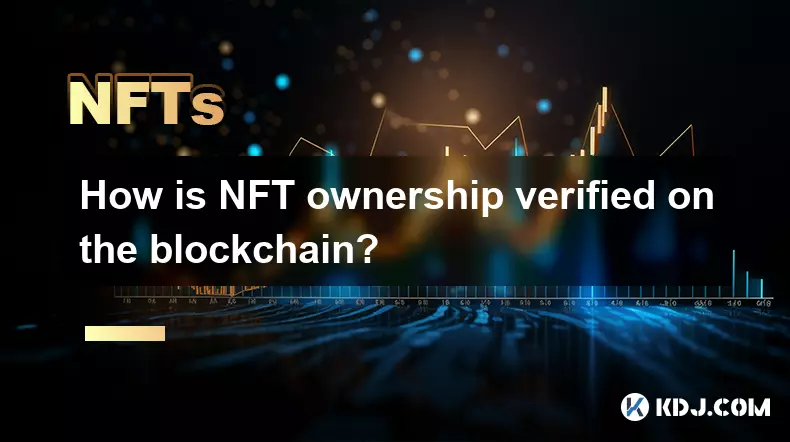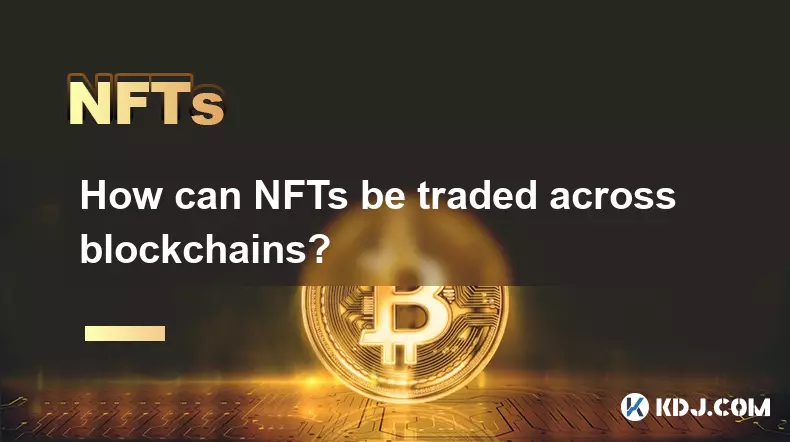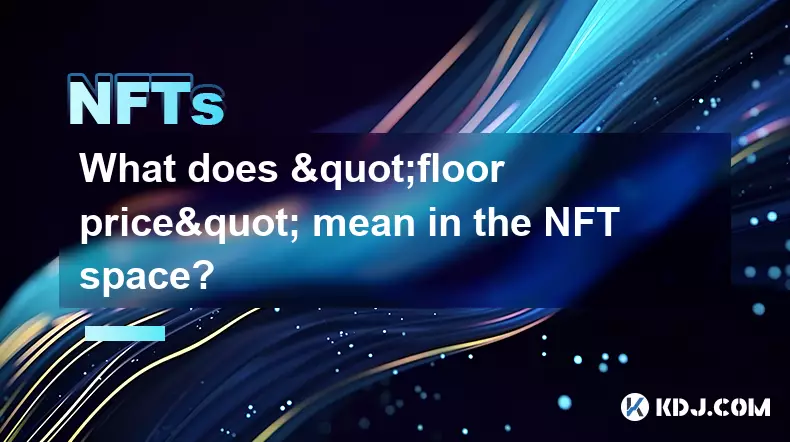-
 bitcoin
bitcoin $109523.663807 USD
-0.13% -
 ethereum
ethereum $4019.526508 USD
2.06% -
 tether
tether $1.000482 USD
0.00% -
 xrp
xrp $2.776815 USD
0.18% -
 bnb
bnb $958.942396 USD
0.12% -
 solana
solana $204.294698 USD
3.84% -
 usd-coin
usd-coin $0.999693 USD
0.00% -
 dogecoin
dogecoin $0.232115 USD
2.09% -
 tron
tron $0.338028 USD
0.84% -
 cardano
cardano $0.790920 USD
1.50% -
 hyperliquid
hyperliquid $44.871443 USD
5.60% -
 ethena-usde
ethena-usde $1.000322 USD
0.04% -
 chainlink
chainlink $21.034165 USD
2.60% -
 avalanche
avalanche $28.794831 USD
-0.54% -
 stellar
stellar $0.360466 USD
1.24%
How is NFT ownership verified on the blockchain?
NFT ownership is securely recorded on the blockchain, with each token linked to a unique wallet address, ensuring transparent, tamper-proof verification of authenticity and provenance.
Sep 11, 2025 at 04:00 pm

Understanding NFT Ownership on the Blockchain
1. Each Non-Fungible Token (NFT) is minted as a unique digital asset recorded on a blockchain, typically Ethereum, Solana, or Polygon. The ownership data is stored within a smart contract that adheres to specific token standards such as ERC-721 or ERC-1155. These standards define how each token tracks ownership and enables transferability.
2. When an NFT is created, the blockchain assigns it a unique identifier tied to a specific wallet address. This address represents the current owner of the token. Every transaction involving the NFT—minting, transferring, or selling—is permanently recorded on the blockchain as a transparent and immutable entry.
3. To verify ownership, anyone can inspect the blockchain using block explorers like Etherscan or Solscan. By entering the NFT’s contract address and token ID, users can view its entire transaction history and confirm the current holder’s wallet address. This public ledger ensures trust without requiring centralized authorities.
4. Smart contracts play a crucial role in maintaining ownership integrity. They automatically enforce rules for transferring tokens, ensuring only the rightful owner can initiate a sale or transfer. Once a transaction is confirmed by the network, the ownership update is distributed across all nodes in the blockchain.
5. The decentralized nature of blockchain eliminates the risk of counterfeit ownership records, making NFT verification both secure and transparent. Unlike traditional digital files that can be copied endlessly, the blockchain confirms which copy is the original through cryptographic proof.
Role of Wallet Addresses in NFT Verification
1. Every participant in the NFT ecosystem interacts with the blockchain through a cryptocurrency wallet. These wallets generate public addresses used to send, receive, and store digital assets. An NFT’s ownership is directly linked to the public address holding it.
2. While wallet addresses are pseudonymous, they serve as verifiable identity markers on the blockchain. Anyone can view the assets held by a given address without knowing the real-world identity behind it. This balance between privacy and transparency supports open verification.
3. When an NFT changes hands, the transaction includes the sender’s and recipient’s addresses, along with the token ID and timestamp. Nodes on the network validate this data before adding it to the next block, ensuring accurate ownership updates.
4. Marketplaces like OpenSea or Magic Eden rely on wallet connectivity to display user-owned NFTs. By connecting a wallet, platforms query the blockchain to fetch all NFTs associated with that address, presenting them in a user-friendly interface.
5. Wallet-based verification empowers users to prove ownership instantly, simply by demonstrating control over the private key linked to the holding address. This cryptographic proof is foundational to trustless digital asset exchange.
Immutable Records and Transaction History
1. The blockchain maintains a chronological chain of blocks, each containing batches of verified transactions. Once an NFT transaction is included in a block, altering or deleting it would require changing every subsequent block across the majority of the network—an impractical feat due to computational and economic constraints.
2. Each NFT carries a complete lineage from its point of creation. Users can trace every prior owner, sale price, and transfer date. This provenance adds value, especially for collectibles and digital art where authenticity and origin matter.
3. Decentralized storage solutions like IPFS often host the metadata and media files linked to NFTs. While the file itself may reside off-chain, the token’s ownership and reference to the content remain secured on the blockchain.
4. Even if a marketplace shuts down, the ownership record persists because it exists independently on the blockchain. Users retain full access to their assets as long as they control their wallet keys.
5. The permanence of blockchain records ensures that NFT ownership cannot be erased or falsified, providing long-term reliability in digital ownership claims.
Frequently Asked Questions
How can I check who owns a specific NFT?To find the owner of an NFT, use a blockchain explorer compatible with the network it was minted on. Enter the NFT’s contract address and token ID to view its current wallet holder and transaction trail.
Can someone steal my NFT if they have my wallet address?No. A wallet address alone does not grant access. Theft requires possession of the private key or seed phrase. Public addresses are meant to be shared and are necessary for receiving tokens.
What happens if I lose access to my wallet with NFTs?If you lose your private key or recovery phrase, access to the wallet and its contents—including NFTs—is permanently lost. There is no central authority to restore access, emphasizing the importance of secure backup practices.
Do all NFTs use the same method for ownership verification?Most NFTs follow standardized protocols like ERC-721 or SPL tokens on Solana, which provide consistent ownership tracking. However, implementation details vary slightly across blockchains, though the core principle of address-based ownership remains universal.
Disclaimer:info@kdj.com
The information provided is not trading advice. kdj.com does not assume any responsibility for any investments made based on the information provided in this article. Cryptocurrencies are highly volatile and it is highly recommended that you invest with caution after thorough research!
If you believe that the content used on this website infringes your copyright, please contact us immediately (info@kdj.com) and we will delete it promptly.
- Token Costs, AI Scaling, and Computing Power: The Quest for Efficiency
- 2025-09-27 14:25:15
- Qwen3Guard: A Leap Towards Multilingual AI Safety
- 2025-09-27 14:25:15
- Rare 1p Coin Could Fetch £200,000: Are You Holding a Fortune?
- 2025-09-27 12:25:13
- MAGACOIN Finance: Buzz, Risks, and the Altcoin Stampede
- 2025-09-27 12:25:13
- Crypto Wallets & Utility Tokens: What's the Hype?
- 2025-09-27 12:30:02
- Coin Memes, Pumpfun, and ChatGPT: Navigating the Wild West of Crypto
- 2025-09-27 14:30:01
Related knowledge

How can I determine the authenticity of an NFT project?
Sep 23,2025 at 05:18pm
Understanding the Project Team and Their Background1. Research the identities of the team members behind the NFT project. Verified social media profil...

What's the difference between NFTs and traditional collectibles?
Sep 19,2025 at 12:55pm
Digital Ownership and Provenance1. NFTs are built on blockchain technology, which ensures transparent and immutable records of ownership. Every transa...

How can NFTs be traded across blockchains?
Sep 19,2025 at 12:00pm
Understanding Cross-Chain NFT Trading1. Non-fungible tokens (NFTs) are digital assets that represent ownership of unique items on a blockchain. Origin...

How is NFT rarity calculated?
Sep 18,2025 at 07:54pm
Understanding NFT Rarity Metrics1. NFT rarity is determined by analyzing the uniqueness of individual traits within a collection. Each NFT typically c...

What does "floor price" mean in the NFT space?
Sep 22,2025 at 06:36am
Floor Price: A Core Metric in the NFT Marketplace1. The term floor price refers to the lowest current asking price for any item within a specific NFT ...

How do NFTs help content creators?
Sep 18,2025 at 08:00am
NFTs Empower Creators with Ownership and Monetization1. NFTs provide content creators with verifiable ownership of their digital works, ensuring authe...

How can I determine the authenticity of an NFT project?
Sep 23,2025 at 05:18pm
Understanding the Project Team and Their Background1. Research the identities of the team members behind the NFT project. Verified social media profil...

What's the difference between NFTs and traditional collectibles?
Sep 19,2025 at 12:55pm
Digital Ownership and Provenance1. NFTs are built on blockchain technology, which ensures transparent and immutable records of ownership. Every transa...

How can NFTs be traded across blockchains?
Sep 19,2025 at 12:00pm
Understanding Cross-Chain NFT Trading1. Non-fungible tokens (NFTs) are digital assets that represent ownership of unique items on a blockchain. Origin...

How is NFT rarity calculated?
Sep 18,2025 at 07:54pm
Understanding NFT Rarity Metrics1. NFT rarity is determined by analyzing the uniqueness of individual traits within a collection. Each NFT typically c...

What does "floor price" mean in the NFT space?
Sep 22,2025 at 06:36am
Floor Price: A Core Metric in the NFT Marketplace1. The term floor price refers to the lowest current asking price for any item within a specific NFT ...

How do NFTs help content creators?
Sep 18,2025 at 08:00am
NFTs Empower Creators with Ownership and Monetization1. NFTs provide content creators with verifiable ownership of their digital works, ensuring authe...
See all articles










































































